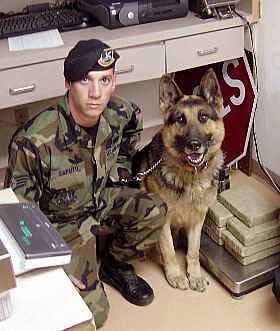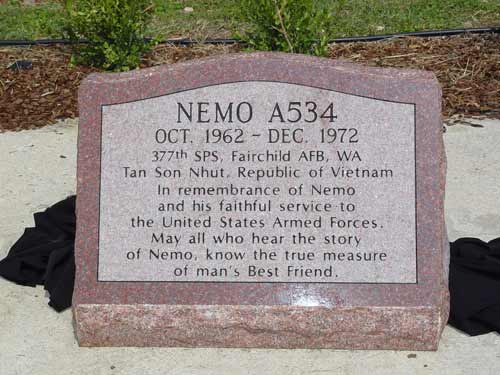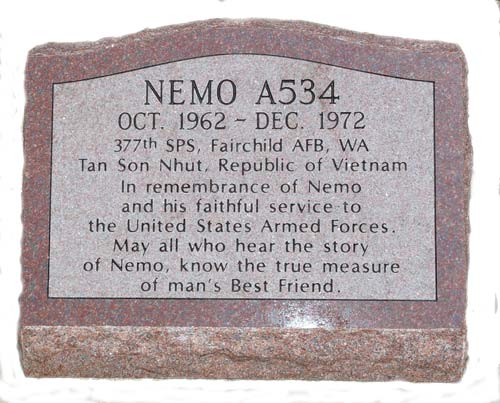Dog team assists with
drug bust 05/13/03 - PETERSON AIR FORCE BASE, Colo. (AFPN) -- A 21st Space Wing military working dog team was key in a recent bust on the Mexican border that netted $375,000 worth of cocaine. Staff Sgt. Joseph Saputo and his dog, Nero, both from the 21st Security Forces Squadron, were on temporary duty supporting the U.S. Bureau of Customs and Border Protection. "We were called to search a car," said Saputo. "Nero showed a big interest underneath both rear wheels, so we opened the trunk and let him search it. He immediately responded. Customs agents removed the back seat (where) they found a compartment with 25.83 pounds of cocaine." This was just one of the many hiding places Saputo and Nero saw during their three months on the border. "It was pretty crazy to see how many different ways people tried to hide drugs," said Saputo. "We saw drugs found in false floors, gas tanks, dash boards, door panels, roofs and even tires. Some people just toss it in the trunk." Some hiding places are more creative. "One of the hardest loads to discover was in a propane tank," said Saputo. "An X-ray of a vehicle carrying a propane tank only showed the side of the tank. A second X-ray showed a storage compartment, a dog alerted on it, and then it didn't sound right when it was tapped on. There were drugs inside." Drug traffickers have many schemes to get drugs over the border. One bust came in the form of painted vehicles. "One group of smugglers painted a couple (of) vehicles to look like U.S. Border Patrol vehicles," said Saputo. "They stuffed the vehicles full of drugs and tried to come through the border, but they got busted." All of the experiences served as an educational opportunity for the K-9 team. "It was a really good experience to work with customs agents and see how their dogs respond," said Saputo. "Customs dogs train with (a) large variety of odors, so they are exposed to a lot more things. We got to train with them once a week. It taught me . how to conduct more thorough searches." "Handlers definitely benefit from the real-world experience they get working with customs," said Tech. Sgt. Richard Vanwinkle, 21st SFS kennel master. "They get to experience an aspect of the job they won't see on an Air Force base." (Story re-printed courtesy of AFNEWS - Air Force Print News http://www.af.mil/news/ )
From Biscuits to Gravy
03/10/03 - F.E. WARREN AIR FORCE BASE, Wyo. (AFPN) -- Barry has retired from the 90th Space Wing Security Forces here after 11 years of battling crime. He was obedient, loyal, vigilant and protective. Barry was an ideal military working dog. The Air Force purchased Barry in 1991 for $3,500 from a Belgium breeder. He was one of only three Belgium Turvueren dogs actively deployed in the entire Air Force. The breed is distinguished by their long hair and charcoal color. After completing a physically demanding and mentally challenging K-9 training course at Lackland Air Force Base, Texas, Barry was assigned to Warren -- his first and only duty station -- as an explosives detection dog. Throughout his career, Barry served in a variety of roles, including four deployments overseas supporting Operation Southern Watch. During his tour here, Barry searched thousands of vehicles and buildings, and he provided special protection to dignitaries like Presidents Bill Clinton and George W. Bush and Vice President Dick Cheney. He served with nine different handlers and earned a 98 percent proficiency rate in explosive detection. Until recently, retirement wasn't an option for military working dogs. Those dogs that could no longer perform their full duties in a field assignment were either sent back to Lackland to train new handlers or were offered to civilian law enforcement agencies. Now Barry and other dogs like him can be adopted after their military service, thanks to the Robby Bill, passed by Congress three years ago. Robby was the first military working dog to be formally adopted, opening the doors to hundreds of dogs following a successful military career. A dog's retirement from the military is similar to a person's -- some paperwork has to be done before they go. First, a veterinarian identifies the dog as physically unable to perform assigned duties. This usually occurs between the 10- to 12-year mark. At the end of a military working dog's career, the dog is worth an estimated $75,000 based on experience and training. As a valuable asset, the next step is to deem the dog "non-deployable or stateside deployment only." The dog's records are then sent to Lackland for a full medical review board. In Barry's case, the board concurred with the veterinarian's request to retire him. Next, the dog is offered to local law enforcement or prior Air Force handlers depending on how old the dog is and its aptitude for continued law enforcement service outside of the military. Then, an interview process is conducted to find suitable homes for the dogs to live out their remaining years. Staff Sgt. Rodney Dove, a base dog handler, was part of Barry's interview process. Dove's adoption application was approved after Barry was not claimed for local law enforcement duties. Dove's adoption approval was a popular one, not only with the handler, but also with squadron members. "This is the first retirement of a military working dog that I've witnessed in 12 years of active duty service," said Staff Sgt. Jack Waid of the 90th Security Forces Squadron commander's support staff. "It was great to see a handler adopt him." Upon retirement, the 90th SFS commander presented Barry with retirement orders and an unofficial but highly appropriate "Meritorious Service Medal." (Story re-printed courtesy of AFNEWS - Air Force Print News http://www.af.mil/news/ )
Handlers Train for Mission
Success
Air Force News | Omar Villarreal | February 06, 2006
MACDILL Air Force Base, Fla. - Author
Corey Ford once wrote, “Properly trained, a man can be dog’s best
friend.”
|




